
Reference Publication: Parker, D.S., J. R. Sherwin and M. T. Anello, January 2001. "Executive Summary: FPC Residential Monitoring Project: New Technology Development - Radiant Barrier Pilot Project," Contract Report FSEC-CR-1231-01-ES , Florida Solar Energy Center, Cocoa, Florida. Disclaimer: The views and opinions expressed in this article are solely those of the authors and are not intended to represent the views and opinions of the Florida Solar Energy Center. |
Executive Summary:
FPC
Residential Monitoring Project: New Technology
Development - Radiant Barrier Pilot Project
D.S.
Parker, J. R. Sherwin and M.
T. Anello
Florida
Solar Energy Center (FSEC)
FSEC-CR-1231-01-ES
Executive Summary (to view the entire report click here)
The FPC Monitoring project has evaluated radiant barrier systems (RBS) as a new potential DSM program. The objective was to examine how the retrofit of attic radiant barriers can be expected to alter FPC residential space conditioning loads. An RBS consists of a layer of aluminum foil fastened to roof decking or roof trusses to block radiant heat transfer between the hot roof surface and the attic below. The radiant barrier can significantly lower summer heat transfer to the attic insulation and to the cooling duct system. Both of these mechanisms have strong potential impacts on cooling energy use as illustrated in Figures E-1 and E-2.
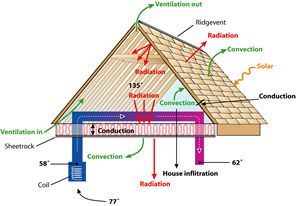 |
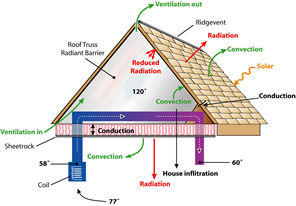 |
Figure
E-1. Heat transfer mechanisms for standard vented attic. |
Figure
E-2. Altered attic heat transfer mechanisms due to RBS. |
The pilot
project involved installation of RBS in nine homes which had been
extensively monitored over the preceding year. The houses varied in
conditioned floor area from 939 to 2,440 square feet; attic insulation
varied from R-9 to R-30. The homes had shingle roofs with varying
degrees of attic ventilation. The radiant barriers were installed
during the summer of 2000 (Figures E-3 and E-4). The first was installed
on June 22nd and the last was installed on September 16th. One home,
the last installation, was excluded from the analysis due to its late
application date which left too little summer data to perform a reliable
estimate.
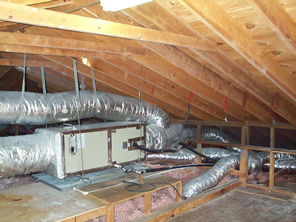 |
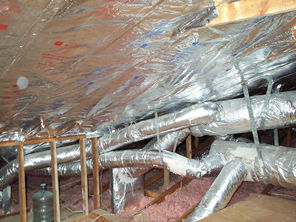 |
Figure
E-3. Site #199 pre retrofit. Note attic air handler. |
Figure
E-4. Site #199 after RBS application. |
Data analysis on the pre and post cooling and heating consumption was used to determine impacts on energy use and peak demand for the utility. The pre and post periods were carefully matched so that time periods evaluated and outdoor air temperatures were nearly identical. Based on the performance at the individual sites, we performed an overall evaluation of the savings from the radiant barrier systems by preparing a composite load profile for the average of the eight sites.
The average cooling energy savings from the RBS retrofit was 3.6 kWh/day, or about 9%. The average reduction in summer afternoon peak demand was 420 watts (or about 16%). The aggregate load profile for all eight sites pre and post RBS installation is shown in Figure E-5. There was an average 8 degree drop in the average maximum daily summer attic temperature. Reductions on the hottest days were greater. Perhaps more importantly, the measured interior air temperature in the homes averaged over 2oF cooler post RBS retrofit, indicating the application had beneficial impacts to customer comfort.
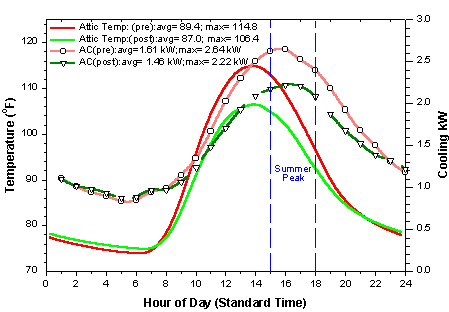 |
|
For comparison, we analyzed the influence of higher levels of ceiling insulation from the summer data taken in the FPC monitoring project. We compared cooling energy use and demand profiles in a large sample of homes with R-19 or R-30 attic insulation. Customers with R-30 used 3.4 kWh/day less for cooling than did homes with R-19. However, the peak demand reduction due to the higher insulation was only 130 Watts (5%). Although the technologies produce roughly the same energy savings for the customer, the RBS resulted in a peak reduction three times greater than added insulation. We hypothesize this is partly due to reduced heat gains to the duct system in the attic and also because radiation potential between roof and attic is greatest during peak cooling demand periods.
Analysis of winter data collected in 2001 showed small benefits of the RBS to reducing space heat demand during the morning peak demand period. This occurs because the RBS do not allow the attic to become as cold during winter nights (lower radiative losses to the night sky).
Based on our findings, we recommend that radiant barrier systems be considered for homes with shingle roofs both in FPC's Home Energy Improvement program as well as emphasized in FPC's new homes program where installations would be most cost effective.
To view the entire report click here
